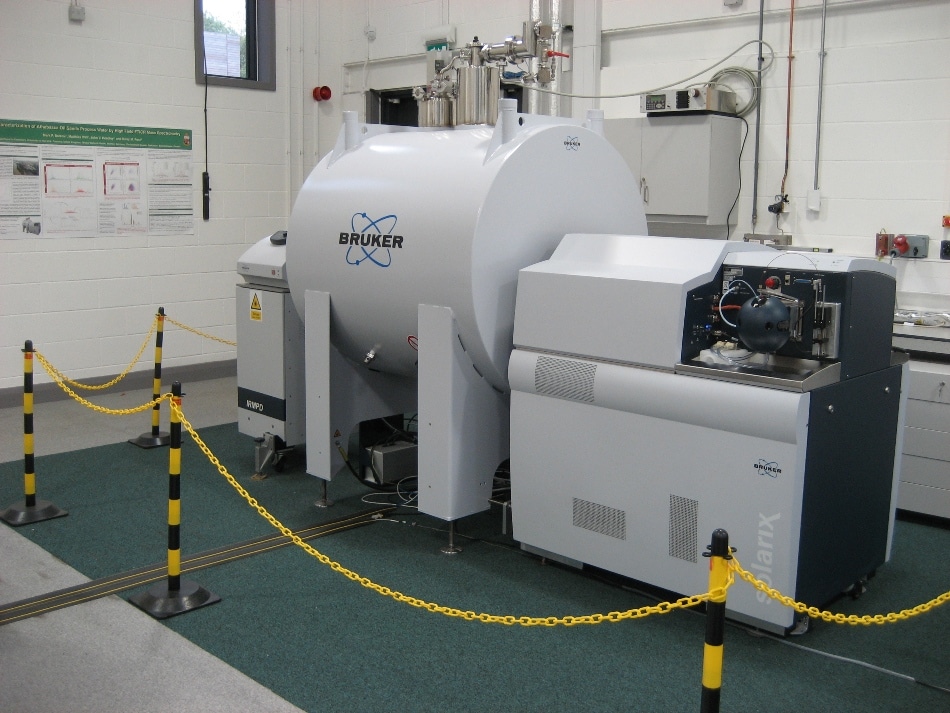Aug 8 2019
At the University of Warwick, researchers have created a new and more robust technique for inspecting chemical mixtures. This latest method improves the assignment of elemental compositions of molecules.
 The FT-ICR MS instrument used in the study. (Image credit: University of Warwick)
The FT-ICR MS instrument used in the study. (Image credit: University of Warwick)
As a matter of fact, the technique has assigned a record-breaking number of 244,779 molecular compositions in just one sample of petroleum.
With nearly a quarter of a million separate compositions assigned within a non-distillable fraction of crude oil, the latest technique developed by the Barrow Group at the University of Warwick’s Department of Chemistry presents new opportunities for analyzing complex samples across a range of fields. The study results have been described in the journal, Chemical Science.
In many industries, assigning the molecular compositions in a complex mixture is considered a useful tool. This is because the elemental composition of such molecules can offer important data for research, help establish the viability of the mixture such as in the petrochemical sector, or even “fingerprint” a complex mixture like environmental or oil samples.
The scientists created a new technique known as operation at constant ultrahigh resolution, or OCULAR for short. This method integrates data processing and experimental techniques that enabled the scientists to define the most challenging sample that they have worked on to date.
With the help of Fourier transform ion cyclotron resonance mass spectrometry (FT-ICR MS), the scientists examined a heavy petroleum sample in solution. They subsequently ionized, activated, and identified the molecules in the sample to establish the mass-to-charge ratios utilizing Bruker Daltonics’ solariX FT-ICR mass spectrometer (FT-ICR MS) at the University of Warwick.
The mass accuracy and ultra-high resolving power of the FT-ICR MS enabled the researchers to establish the elemental compositions in even the most challenging samples, with a high degree of confidence.
When analyzing a broad m/z range, conventional analysis carried out with a range of Fourier transform mass spectrometers (FTMS) provides decreasing resolving power and thus a low degree of confidence in assignments of the elemental compositions at higher m/z.
However, in the latest OCULAR technique, ions are examined utilizing smaller data segments based on their mass. Here, the experiment is engineered in a unique way to make sure that almost constant resolving power across the entire mass range is examined; a constant resolving power of three million was utilized to characterize a heavy petroleum sample in the published example.
With the help of an algorithm created by the team, a complete mass spectrum (relative abundance versus m/z) can be generated by automatically preparing the segmented data and then stitching it together.
Since each peak denotes one molecular composition, the entirety of the mass spectrum covers the sample’s compositional space. This enabled the researchers to work at relatively higher resolution and also deal with problems relating to space-charge effects, where a huge number of ions will influence the precision of the mass measurement. The outcome was detection, resolution, and assignment of the largest number of peaks within a single sample to date.
The method can be used for analyzing any kind of complex mixture and could also be used in areas like materials (for example, polymers), life sciences and healthcare (for example, metabolomics, proteomics, and cancer research), energy (for example, biofuels and petroleum), and environmental analysis, including being used to “fingerprint” oil spills through their molecular composition.
This method can improve the performance of a range of FTMS instruments, including high and low magnetic field FT-ICR MS instruments and Orbitrap instruments. We are now able to analyse mixtures that, due to their complexity, are challenging even for the most powerful analytical techniques. This technique is flexible as the performance can be selected according to the research needs.
Dr Diana Palacio Lozano, Study Lead Author, Department of Chemistry, University of Warwick
Samples of petroleum are innately quite complex and hence they were the most optimized test for this kind of technique. As the global use of petroleum drives the shift to heavier oils, the samples are turning out to be more complex. Hence, there is also more demand for this kind of analysis by petrochemical researchers.
In addition, the low volatility of the heavier oil can now be described by the unusually complex elemental composition. The complex nature of heavy oils can impede with catalysis and have an impact on extraction, refining, and transport processes.
Moreover, the OCULAR method is sufficiently powerful to be utilized on samples requiring the highest performance to assign compositions on the basis of fine isotopic patterns or mass accuracy.
The OCULAR approach allows us to push the current analytical limits for characterizing the most complex samples. It significantly extends the performance of all FTMS instruments at no additional cost and works well with developments in the field, such as newer hardware designs, detection methods, and data processing methods. OCULAR is highly versatile, the experiments and processing can be adapted as needed, and the approach can be applied to many research areas, including energy, healthcare, and the environment.
Dr Mark Barrow, Principal investigator, Department of Chemistry, University of Warwick